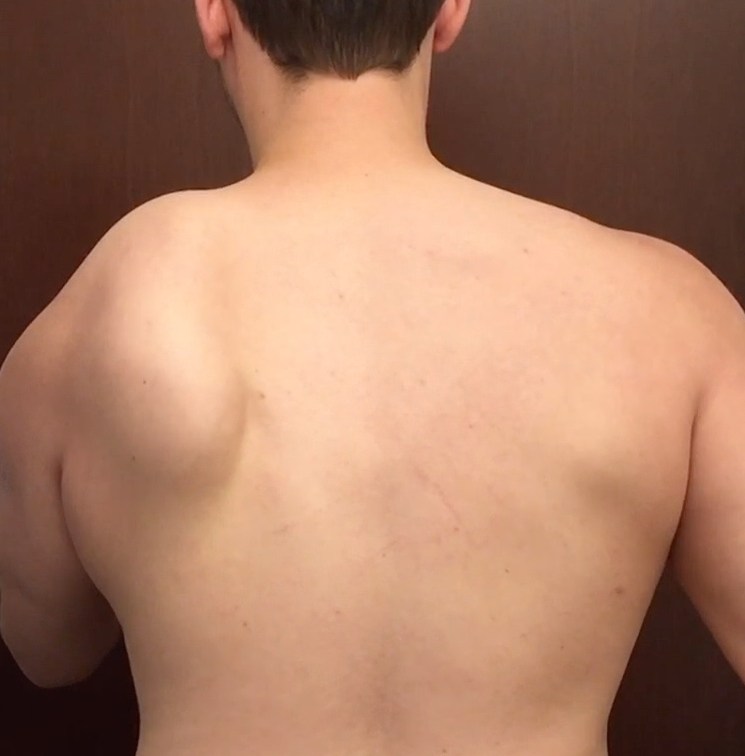MAJOR CAUSES OF SCAPULAR DISORDERS
• Weakness, imbalance, tightness, or detachment of the muscles that control the scapula
• Injuries to the nerves that supply the muscles
• Injuries to the bones that support the scapula or injuries within the shoulder joint
SYMPTOMS OF SCAPULAR DISORDERS
• Pain with or without tenderness around the scapular region, particularly on the top and medial border
• Weakness in the affected arm, the arm may feel “tired” or “dead” when you try to use the it in a vigorous way
• Feeling fatigue with repetitive activities, especially overhead movements
• Limited range of motion, raising the arm above the shoulder height becomes difficult
• A “crunching” or “snapping” sound with shoulder movement
• Noticeable protrusion or “winging” of the scapula
• A drooped or forward tilted posture on the affected side
HOME REMEDIES
Following are some of the simple home remedies with which symptoms of scapular disorders may improve.
Restoring good posture – As you go about doing your day-to-day activities, make sure you are standing and sitting properly. To do this, pull your shoulder blades back together, and bend your elbows down and back as if you are trying to put them in your back pockets.
Proper exercise routine – If you do regular exercise programme make sure you have a balanced upper body strength sessions. It is ideal to include stretching exercises for your front shoulder muscles and for shoulder joint rotation.
Heat therapy – Soaking in a hot bath tub or using a heating pad may help relax tight shoulder muscles.
If your symptoms linger even after the above-mentioned home remedies, it is time to consult your doctor. He/She can help identify the exact cause of your scapular disorder and can chalk out a treatment plan accordingly.
PHYSICAL EXAMINATION
Your doctor will discuss about your overall health, past medical history and ask about the symptoms you have. Following that he/she will conduct a thorough physical examination, looking for injury, pain, weakness or tightness. In general, doctor’s physical exam includes the following sessions:
Visual observation – Your doctor will have a closer look at the infected shoulder from behind, comparing it to the noninvolved shoulder. In order to check if a severe scapular disorder is present you may be asked to move your arms up and down three to five times. This is to reveal any weakness in the muscles and check the disorder pattern.
Manual muscle testing – This involves strength testing of the shoulder and scapular muscles to check if muscle weakening is the reason behind abnormal scapular motion.
IMAGING STUDIES
Imaging studies are not always a standard procedure to arrive at a diagnosis of scapular disorders. However, your doctor may order one, such as an x-ray, computerised tomography (CT) or magnetic resonance imaging (MR), if there is suspicion of a bony abnormality of the scapula or the injury extends to the other part of the shoulder.
NON-SURGICAL TREATMENTS
Generally symptoms of scapular disorders improve with non-surgical treatments which may include:
• Nonsteroidal anti-inflammatory drugs: NSAIDs, such as ibuprofen and naproxen, can help relieve pain and swelling
• Physiotherapy – Your doctor or physiotherapist may set an exercise programme for you that targets the exact cause of the disorder. The objective of the physiotherapy is to strengthen and stabilise the shoulder muscles and stretch the muscles that restrict range of motion
SURGICAL PROCEDURE
If the muscle weakness is out of weakness and tightness, surgery may not be required. However, if the scapular disorder is due to a severe injury to the shoulder, your doctor may resort to performing a surgical procedure to repair and reconstruct injured tissues. Normal scapular motion can be regained through proper rehabilitation after the surgery.
For enquiries related to Scapular Disorders, drop a message to www.BangaloreShoulderInstitute.com/contact

